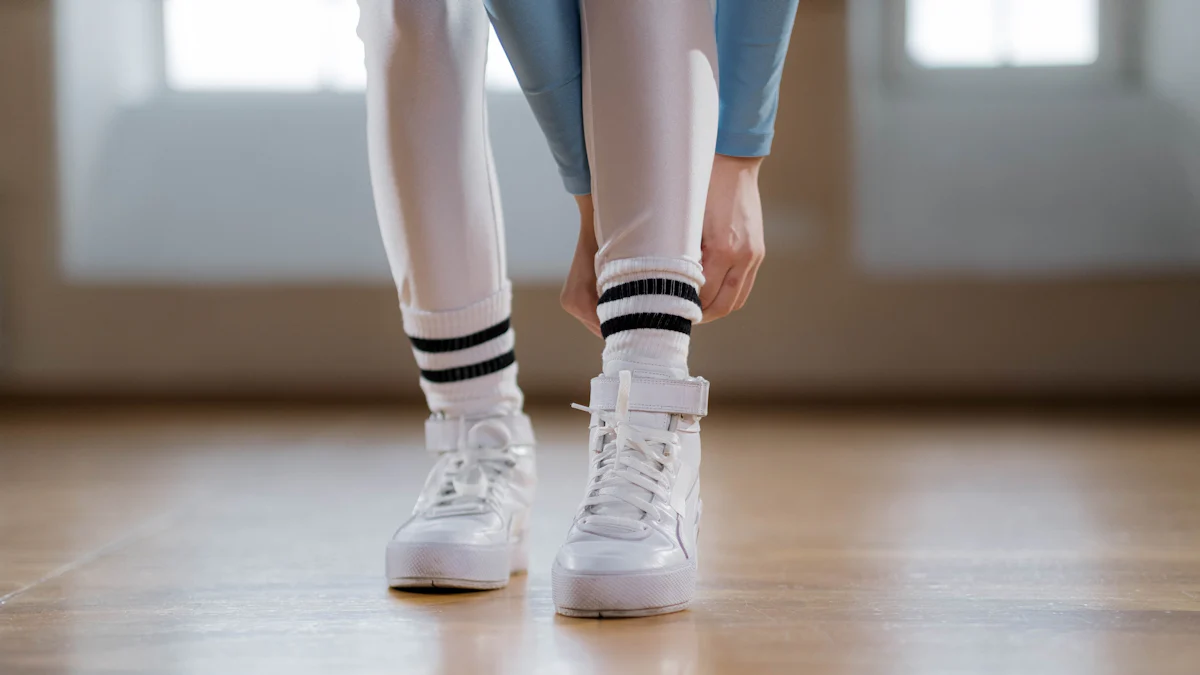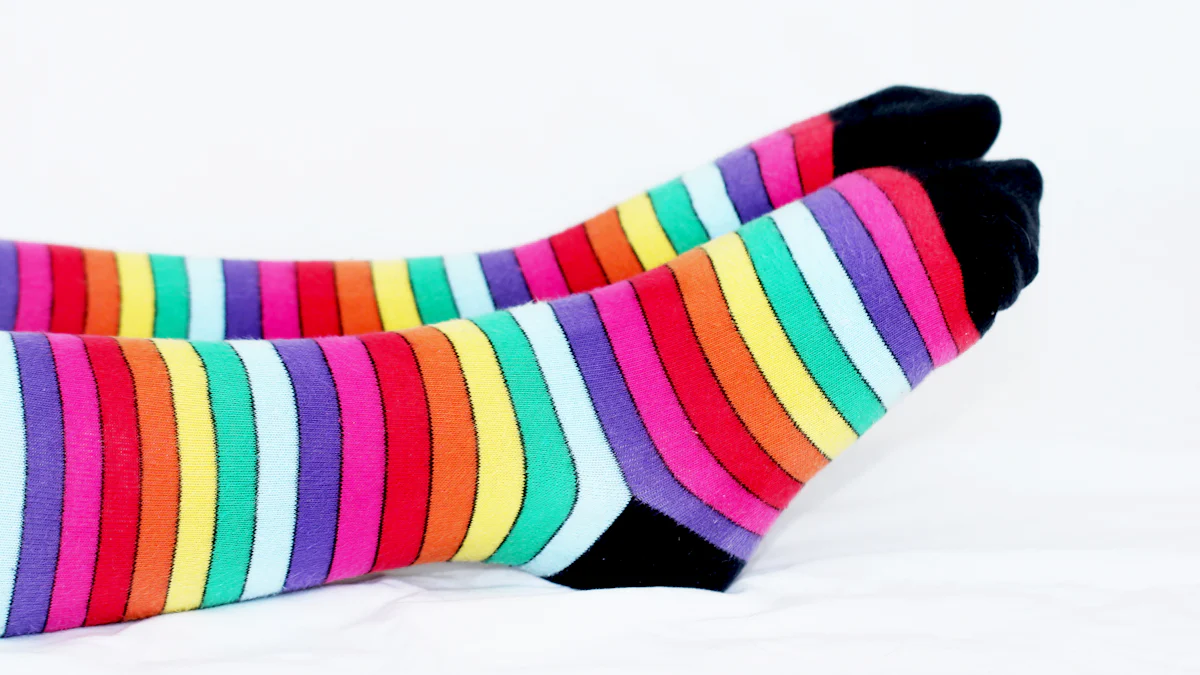
Sock material plays a crucial role in ensuring comfort for your feet. Nylon polyester socks stand out due to their unique properties. These materials offer different levels of softness, durability, and moisture-wicking capabilities. Nylon provides exceptional strength and smoothness. Polyester excels in breathability and sweat control. Understanding these aspects helps you make an informed choice for your needs. The comparison between nylon and polyester socks reveals the best option for comfort and performance.
Comfort and Fit
Material Softness
Nylon Softness
Nylon offers a smooth texture that enhances comfort. The softness of nylon polyester socks provides a gentle feel against the skin. This material’s smoothness makes it ideal for those seeking a luxurious touch. Nylon’s ability to maintain its softness even after multiple washes adds to its appeal. The material’s skin-friendliness ensures minimal irritation during wear.
Polyester Softness
Polyester also offers a comfortable experience. The softness of polyester in nylon polyester socks provides a cozy fit for everyday use. Polyester maintains its softness over time, making it a reliable choice. The material’s structure contributes to a pleasant wearing experience. Polyester’s softness complements its other properties, enhancing overall comfort.
Elasticity and Fit
Nylon Elasticity
Nylon excels in elasticity, providing a snug fit. The stretchability of nylon polyester socks ensures they conform well to foot shapes. Nylon’s elasticity absorbs shock effectively, offering support during activities. This property makes nylon ideal for sports and high-impact scenarios. The fit remains consistent, preventing slippage and discomfort.
Polyester Elasticity
Polyester offers moderate elasticity, ensuring a comfortable fit. The elasticity of polyester in nylon polyester socks provides adequate support for daily activities. Polyester’s stretchability adapts to various foot sizes, enhancing comfort. The material maintains its shape, ensuring a consistent fit over time. Polyester’s elasticity contributes to a secure and comfortable wearing experience.
Durability and Longevity
Wear and Tear Resistance
Nylon Durability
Nylon polyester socks offer impressive durability. The strength of nylon fibers provides excellent resistance to tearing and abrasion. This quality makes nylon a preferred choice for activities that demand robust performance. The smooth texture of nylon also contributes to its ability to withstand wear over time. Frequent washing does not compromise the integrity of nylon socks, ensuring long-lasting use.
Polyester Durability
Polyester socks also deliver strong durability. The tightly woven fibers in polyester resist pilling and maintain their structure well. Polyester’s resistance to tears and abrasions makes it suitable for everyday wear. Quick-drying properties enhance the longevity of polyester socks by reducing moisture-related damage. Polyester maintains color vibrancy, adding to its aesthetic appeal over time.
Longevity in Daily Use
Nylon Longevity
Nylon polyester socks excel in daily use longevity. The resilience of nylon fibers ensures socks retain their shape and fit after repeated use. Nylon’s ability to repel natural oils helps prevent odors, extending the freshness of the socks. The material’s elasticity supports consistent performance, making nylon a reliable option for regular wear. Nylon’s smoothness minimizes friction, reducing the risk of blisters and enhancing comfort.
Polyester Longevity
Polyester socks provide dependable longevity for daily wear. The moisture-wicking properties of polyester keep feet dry, reducing the likelihood of bacterial growth. Polyester’s structure supports a snug fit, maintaining comfort throughout the day. The material’s quick-drying nature prevents prolonged dampness, which can degrade sock quality. Polyester’s durability ensures socks remain functional and visually appealing over time.
Moisture-Wicking and Breathability

Moisture-Wicking Properties
Nylon Moisture-Wicking
Nylon polyester socks excel in moisture-wicking capabilities. Nylon fibers transport sweat away from the skin. This feature keeps feet dry during extended wear. The material’s structure allows for quick evaporation. Nylon socks help prevent foot odor by reducing moisture buildup. This makes nylon a suitable choice for those with sweaty feet.
Polyester Moisture-Wicking
Polyester socks also offer excellent moisture-wicking properties. The fibers in polyester move moisture to the sock’s outer layer. This action facilitates rapid evaporation. Polyester socks keep feet cool and dry, even during intense activities. The quick-drying nature of polyester enhances comfort. This makes polyester an ideal option for athletic pursuits.
Breathability
Nylon Breathability
Nylon polyester socks provide moderate breathability. The material allows air circulation around the foot. This feature helps regulate temperature during wear. Nylon’s breathability contributes to overall comfort. The socks maintain a pleasant feel throughout the day. Nylon’s structure supports ventilation, reducing heat buildup.
Polyester Breathability
Polyester socks offer superior breathability. The fibers allow air to flow freely around the foot. This promotes a cooler and more comfortable experience. Polyester’s breathability helps manage sweat effectively. The material prevents overheating during physical activities. Polyester socks remain comfortable in various conditions.
Color Retention and Aesthetics

Color Retention
Nylon Color Retention
Nylon socks offer impressive color retention. The fibers in nylon resist fading over time. Frequent washing does not affect the vibrant colors of nylon socks. The material maintains its original hue even with prolonged use. Nylon’s ability to hold color enhances the longevity of its aesthetic appeal.
Polyester Color Retention
Polyester socks excel in color retention. The tightly woven fibers prevent color loss. Polyester maintains its brightness through numerous washes. The material resists fading, ensuring a fresh look. Polyester’s color retention makes it a popular choice for those seeking long-lasting vibrancy.
Aesthetic Appeal
Nylon Aesthetics
Nylon socks provide a sleek and polished appearance. The smooth texture contributes to a refined look. Nylon’s elasticity ensures a snug fit that complements various styles. The material’s sheen adds a touch of elegance. Nylon socks suit both casual and formal occasions.
Polyester Aesthetics
Polyester socks offer a versatile aesthetic appeal. The material adapts well to different designs and patterns. Polyester’s durability supports intricate detailing. The fabric’s structure allows for bold and vibrant prints. Polyester socks cater to diverse fashion preferences.
Environmental Impact
Production and Sustainability
Nylon Environmental Impact
Nylon production relies on petroleum-based resources. This process requires significant energy consumption. The manufacturing of nylon contributes to carbon emissions. Microplastic fibers from nylon can enter ecosystems. Recycling technologies aim to reduce these impacts. However, widespread adoption remains limited.
Polyester Environmental Impact
Polyester production also depends on non-renewable resources. The process releases substantial CO2 emissions. Plastic waste and microfibers result from polyester use. These microfibers harm marine and terrestrial environments. Polyester’s non-biodegradable nature poses long-term environmental challenges. Recycling initiatives offer potential solutions for reducing waste.
Biodegradability
Nylon Biodegradability
Nylon does not decompose easily in natural environments. The material’s durability leads to persistent waste. Nylon’s non-biodegradable nature contributes to landfill accumulation. Efforts to improve biodegradability focus on innovative materials. Current solutions remain in developmental stages.
Polyester Biodegradability
Polyester shares similar biodegradability issues with nylon. The material takes a long time to break down. Polyester waste accumulates in landfills and oceans. Microfiber pollution from polyester poses ecological risks. Research explores biodegradable alternatives to traditional polyester. Progress in this area continues to evolve.
Nylon and polyester socks each offer unique benefits. Nylon provides superior durability and softness, making it ideal for those seeking long-lasting comfort. Polyester excels in breathability and moisture-wicking, perfect for active lifestyles. Both materials present environmental challenges due to their non-biodegradable nature. Choosing the right sock material is crucial for comfort and performance. Consider your specific needs to find the best fit. Personal preferences and activities will guide your decision. Opt for a blend that combines the strengths of both materials for optimal results.

